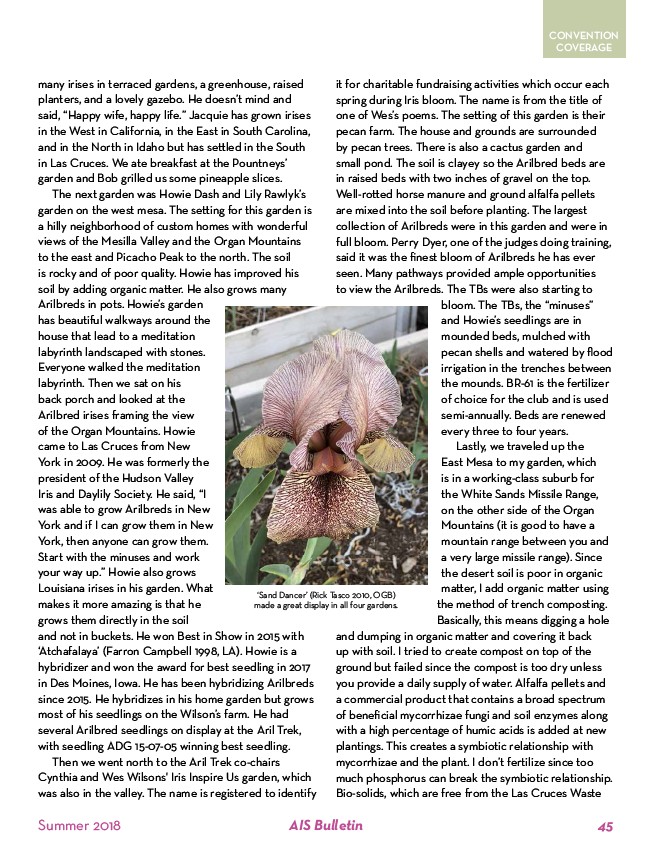
many irises in terraced gardens, a greenhouse, raised
planters, and a lovely gazebo. He doesn’t mind and
said, “Happy wife, happy life.” Jacquie has grown irises
in the West in California, in the East in South Carolina,
and in the North in Idaho but has settled in the South
in Las Cruces. We ate breakfast at the Pountneys’
garden and Bob grilled us some pineapple slices.
The next garden was Howie Dash and Lily Rawlyk’s
garden on the west mesa. The setting for this garden is
a hilly neighborhood of custom homes with wonderful
views of the Mesilla Valley and the Organ Mountains
to the east and Picacho Peak to the north. The soil
is rocky and of poor quality. Howie has improved his
soil by adding organic matter. He also grows many
Arilbreds in pots. Howie’s garden
has beautiful walkways around the
house that lead to a meditation
labyrinth landscaped with stones.
Everyone walked the meditation
labyrinth. Then we sat on his
back porch and looked at the
Arilbred irises framing the view
of the Organ Mountains. Howie
came to Las Cruces from New
York in 2009. He was formerly the
president of the Hudson Valley
Iris and Daylily Society. He said, “I
was able to grow Arilbreds in New
York and if I can grow them in New
York, then anyone can grow them.
Start with the minuses and work
your way up.” Howie also grows
Louisiana irises in his garden. What
makes it more amazing is that he
grows them directly in the soil
and not in buckets. He won Best in Show in 2015 with
‘Atchafalaya’ (Farron Campbell 1998, LA). Howie is a
hybridizer and won the award for best seedling in 2017
in Des Moines, Iowa. He has been hybridizing Arilbreds
since 2015. He hybridizes in his home garden but grows
most of his seedlings on the Wilson’s farm. He had
several Arilbred seedlings on display at the Aril Trek,
with seedling ADG 15-07-05 winning best seedling.
Then we went north to the Aril Trek co-chairs
Cynthia and Wes Wilsons' Iris Inspire Us garden, which
was also in the valley. The name is registered to identify
CONVENTION
COVERAGE
it for charitable fundraising activities which occur each
spring during Iris bloom. The name is from the title of
one of Wes’s poems. The setting of this garden is their
pecan farm. The house and grounds are surrounded
by pecan trees. There is also a cactus garden and
small pond. The soil is clayey so the Arilbred beds are
in raised beds with two inches of gravel on the top.
Well-rotted horse manure and ground alfalfa pellets
are mixed into the soil before planting. The largest
collection of Arilbreds were in this garden and were in
full bloom. Perry Dyer, one of the judges doing training,
said it was the finest bloom of Arilbreds he has ever
seen. Many pathways provided ample opportunities
to view the Arilbreds. The TBs were also starting to
bloom. The TBs, the “minuses”
and Howie’s seedlings are in
mounded beds, mulched with
pecan shells and watered by flood
irrigation in the trenches between
the mounds. BR-61 is the fertilizer
of choice for the club and is used
semi-annually. Beds are renewed
every three to four years.
Lastly, we traveled up the
East Mesa to my garden, which
is in a working-class suburb for
the White Sands Missile Range,
on the other side of the Organ
Mountains (it is good to have a
mountain range between you and
a very large missile range). Since
the desert soil is poor in organic
matter, I add organic matter using
the method of trench composting.
Basically, this means digging a hole
‘Sand Dancer’ (Rick Tasco 2010, OGB)
made a great display in all four gardens.
and dumping in organic matter and covering it back
up with soil. I tried to create compost on top of the
ground but failed since the compost is too dry unless
you provide a daily supply of water. Alfalfa pellets and
a commercial product that contains a broad spectrum
of beneficial mycorrhizae fungi and soil enzymes along
with a high percentage of humic acids is added at new
plantings. This creates a symbiotic relationship with
mycorrhizae and the plant. I don’t fertilize since too
much phosphorus can break the symbiotic relationship.
Bio-solids, which are free from the Las Cruces Waste
Summer 2018 AIS Bulletin 45